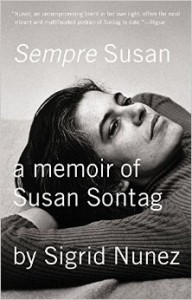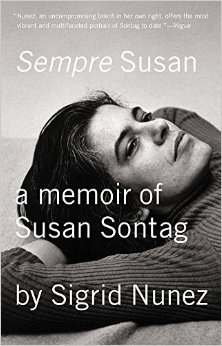 Sempre Susan: A Memoir of Susan Sontag
Sempre Susan: A Memoir of Susan Sontag
by Sigrid Nunez
Atlas & Co. 144 pages, $20.
IN 1976, armed with an MFA from Columbia and in need of an odd job to supplement her free-lance writing, Sigrid Nunez accepted a position as Susan Sontag’s assistant. Sontag had appealed to The New York Review of Books for someone who’d help her catch up on correspondence that had accumulated during the time she’d undergone treatment for breast cancer. At that time, she was also writing Illness as Metaphor, published in 1978.
Nunez, now a widely published novelist and journalist who has stated that Sontag’s influence on her thinking and writing was profound, has written a compellingly readable and even-handed, but all too brief, memoir of her time in the aura of the incandescent—and high-maintenance—Ms. Sontag. Soon after she began working for Sontag, Nunez started to date Sontag’s son David Rieff. She lived part-time at Sontag’s Riverside Drive penthouse, and Rieff lived part-time with his mother. Nunez describes Sontag as open and confiding, happy to share stories about famous people she had met, such as Thomas Mann, as well as the not so famous, such as Sontag’s mother-from-hell (whom Nunez met). Sontag’s lack of boundaries was astonishing, as was her chaotic life. Seldom was there food in the house, and rarely (judging by the description of the penthouse terrace) was David’s dog ever walked. In constant need of stimulating conversation, Sontag would call friends and demand that they visit.
Nunez reveals that she didn’t keep a journal or diary of her time with Sontag, but one wonders if notes were kept surreptitiously. Some of her anecdotes about Sontag are charming. One’s personal library, she once opined, should be arranged by subject, and chronologically within the subject. Holing up in a Manhattan hotel room to write was far preferable than going to a bucolic writers’ colony. We also learn that Sontag worried about her weight, dyed her hair, and wore Dior Homme cologne.
From her teenage years onwards, Sontag had affairs with both men and women. During the summer of her freshman year at Berkeley (as recorded in her 2008 diary Reborn), she kept lists: books to read (Rilke, Conrad, Hesse), and gay slang that was popular at the time. The year was 1949, and Sontag was sixteen years old. Ten years later, as recorded in Reborn, she would write: “My desire to write is connected with my homosexuality. I need the identity as a weapon to match the weapon that society has against me. … Being queer makes me feel more vulnerable. It increases my wish to hide, to be invisible—which I’ve always felt anyway.”
Nunez met a few of the people with whom Sontag was having affairs: poet Joseph Brodsky, who went on to win the Nobel Prize for Literature in 1987; French actress-producer Nicole Stéphane, née Rothschild, who swooped in to care for Sontag during a 1977 hospitalization (they’d been romantically involved years before). Stéphane was followed by the one-named Carlotta, a pre-Stéphane lover, who flew in from Rome. Nunez remarks that Sontag loved to be in love, believed in love, and wanted to be married. But none of her relationships lasted very long. The exception was her final relationship, with photographer Annie Leibovitz, which had lasted for fifteen years at the time of Sontag’s death from leukemia, at age 71, in 2004.






